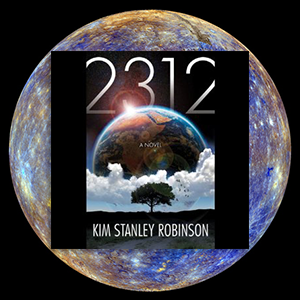Let’s face it, mapping worlds here at CosmoQuest doesn’t always require all your brain. It’s one of those nice, lazy tasks for when you want to just chill out and contribute to science.
The thing is, mapping craters and marking boulders doesn’t always take up my full attention, and that left over part of my brain always seems to want to go see if their is good ice cream in the freezer or check out what’s going on over on Facebook. In order to keep this extra bandwidth busy, I’ve learned to turn on a podcast or audio book, and use my time mapping to also catch up on learning and reading.
For this #SummerOfScience, I’d like to suggest these pairings of audiobooks* and science projects:
 Moon Mappers and the Moon is a Harsh Mistress
Moon Mappers and the Moon is a Harsh Mistress
The craters you are mapping, and the jagged features you mark may be the places where future colonists go to live. In this 1965 classic by Robert Heinlein, you are asked to consider a future where the Moon is a penal colony (think Australia) where Earth’s food is grown in ways that are unsustainable. “The Moon is a Harsh Mistress” forces you to think about science, society, sustainability, and (because it’s Heinlein) relationships of family. This book contains adult themes, and is a product of its time, which means that it’s morays may not be exactly modern.
There are certain books that convince me that I don’t want to be an astronaut. These books convince me I lack the genius, creativity, and physical fortitude. Andy Weir’s “The Martian,” is one of those books. This book tells the story of what happens when things go sideways 6 months away from home (where by “home” I mine “Earth”). It will help you understand the emotional and intellectual roller coaster called survival on another planet. This is a modern tale that gets its science right. Be warned: There is a turning point toward the end where you can no longer put the book down and may find yourself snapping at loved ones who try and tear you away from the final pages.
 Mercury Mappers and 2312
Mercury Mappers and 2312
Good science fiction often forces you to think about what normal means, and consider how morals can flex in the face of technological innovations. Kim Stanley Robinson’s “2312” isn’t an easy book to read, but you will keep reading because it’s turns are so odd that you can’t put it down until you see where it’s going to land. At the heart of this book is an amazing concept for how it may actually be possible to set up a colony on Mercury, and other interesting, and scientifically possible ideas for spreading life (including endangered species) out among the stars planets.
 Vesta Mappers and Leviathan Wakes
Vesta Mappers and Leviathan Wakes
Ok, so this book doesn’t discuss Vesta in particular, but it is set inside a variety of moons and asteroids scattered throughout the Solar System. “Leviathan Wakes” is old school space opera with a dash of zombie influence for spice. If you’ve ever thought about what it would be like to live inside of an asteroid (or moon), this book is for you. Be warned, the future painted by James S.A. Corey isn’t a utopia; there are rich and poor, and there is that kind of life somewhere beyond poor that is nothing more than struggle; and Corey’s hero is just an a**hole trying to figure out how to do right thing.
Of course, these are just my ideas. What are yours? We’d love to hear from you in the comments. You may have other book and celestial body match ups on your mind. Or, you may have something entirely different that you do when you map worlds. Let us know, and let’s make mapping breeze.
*We are linking to books on Audible.com because this is where I get all my audio books. Many of these books are also available through local libraries in audio format, either on CDs or in some cases as downloads. We have received nothing from Audible and aren’t associated with them in anyway.

 Mars Mappers
Mars Mappers


 Join the Crew!
Join the Crew!
 Escape Velocity Space News
Escape Velocity Space News
First Men in the Moon.
Beyond the Blue Event Horizon
Transit of Earth
Aniara by Harry Martinson
I love Weir’s “The Martian” and am reading it for a second time. With regards to craters and boulders, well, I’m not a planetary scientist and some of the formations have me wondering “What exactly am I looking at?” A more thorough set of examples would not go amiss…